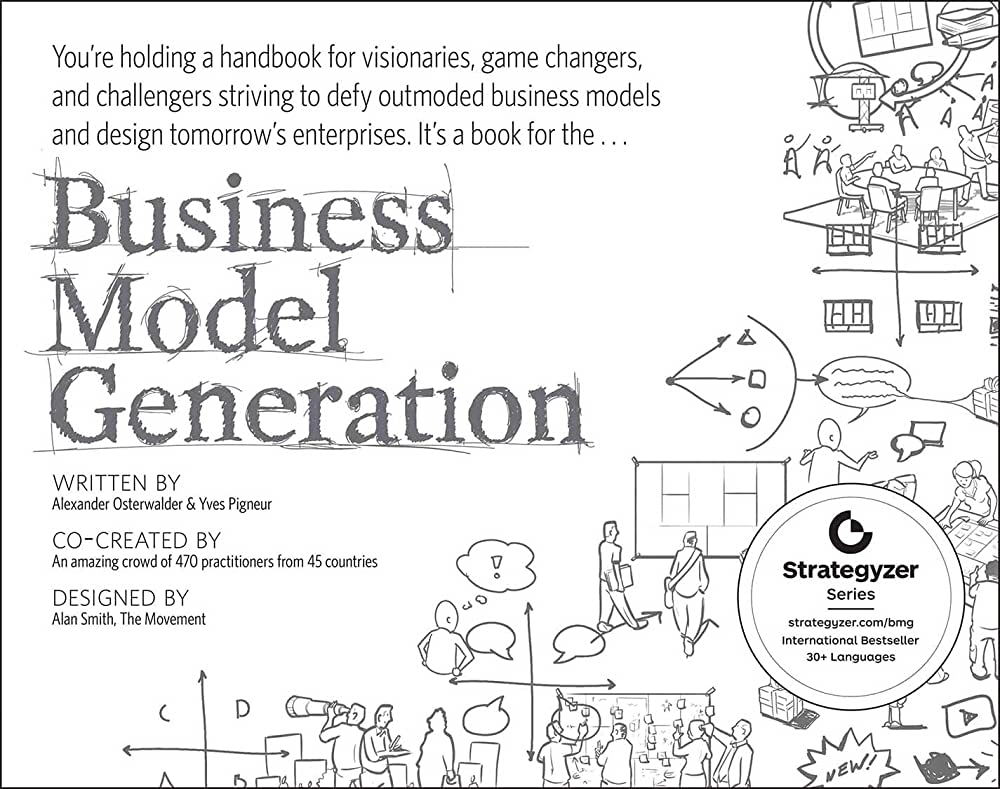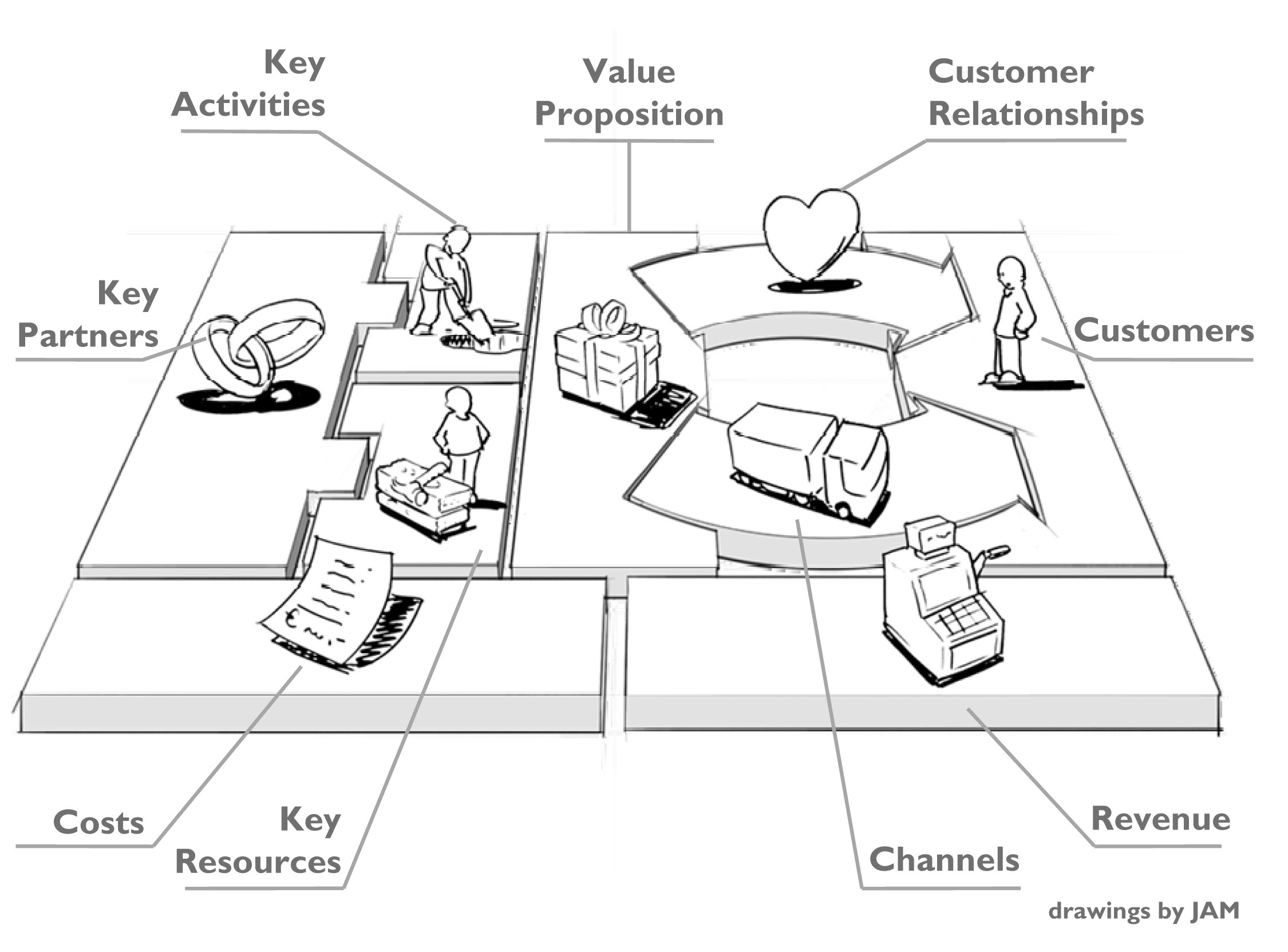Building a Business Model & Playing to Win

Background Thoughts
The best-selling business book of 2010, Business Model Generation (BMG) is the brainchild of Alex Osterwalder and Yves Pigneur, a student and professor respectively. I like that. Like Yves, I had a wonderful and productive time co-creating and co-writing with my student Jennifer Riel, now a star partner at IDEO and a thinker/writer in her own right.
The first point of interest about BMG is that it does not claim to be a strategy framework or even a strategy book. Sure, it gets into strategy from page 200 onwards, but conceptually it is a book about business models. Despite the Swiss restriction, BMG is a more comprehensive strategy framework than almost any other book on the market. Jobs to be done, Disruptive Innovation, Three Horizons, Customer Loyalty, Time-based Competition, etc. are all strategy concepts. Each one of them highlights in a valuable way useful things to keep in mind when strategizing. But they are not strategy frameworks in their own right.
The BMG, by contrast, is clearly a comprehensive strategy framework. In re-reading the BMG for this article, I was impressed by how modern it feels. The book is 13 years old and I would argue that it has held up well. I was particularly impressed by its broad coverage of two-sided markets/platform business models. The seminal papers by Rochet & Tirole and Parker & Van Alstyne in this area were published in 2003 and 2005 respectively. In the world of ideas, there is a blink of an eye between the publication of these papers and the writing of BMG, which took place in 2007-2009 and would be published in 2010. Analyzing Apple, Red Hat, Google and Facebook as platform businesses will not be very insightful in 2023. But 2010 was really early in the platform game. I was very impressed.
I would also be remiss if I didn't mention how much I love BMG's visual format. It shows that a very serious book can have a fun and inviting look and feel. I'm very impressed that they managed to convince the publishers to let them stray so far from publishing traditions. I know that the biggest credit for this innovation goes to the designer Alan Smith, but congratulations to everyone involved!
Benefits of BMG
I see only two comprehensive models for strategy making that are widely used in the business world: PTW and BMG. This is my view and I can imagine that many fans would add Blue Ocean Strategy (BOS) as a third. To me, BOS is an example between a strategy concept and a comprehensive strategy framework. As I mentioned in my earlier post on this topic, I was really impressed by the ideas in BOS, but I don't see it as a comprehensive model that will take a company from 'I don't have a strategy I like' to 'I do'. Rather, I see it as a framework for thinking about some kind of strategy initiative in a specific set of contexts. But if someone wants to see that there are three comprehensive strategy frameworks, that's fine with me.
In addition, I know that many other strategy enthusiasts will say that they have created a comprehensive strategy model, and I'm sure there are many who have done that. But I don't see this kind of model being widely used in the business world - in fact it has a narrow use - so in my view there are only two models that are widely used.
Of course, many strategy scholars will say that the firm's Resource Based View (RBV) is not only the most important strategy framework, but also the only correct one. I have made my views on the RBV clear earlier in this series, so I will not repeat the arguments. You can find them here and here. I think it has little utility as a strategy framework and the business world treats it as such. It has been 39 years since Birger Wernerfelt's first article on the RBV was published and I have been advising companies on strategy for each of those 39 years. In those (nearly) four decades I have witnessed only one mention of the RBV by any employee of any company. Admittedly, it is also used by some real business people with whom I have never interacted. But not very many - and for good reason. It's a framework built by business academics for business academics - a wonderful closed loop. This closed loop is not violated by their students because they drop it when they enter the real world and find that it is incompatible with making useful decisions in that world.
In contrast, the BMG is widely used. It lays out the nine parts of the Business Model Canvas and provides a clear theory of how these parts should fit together. It focuses on the whole, not the parts. And it provides example after example to support its concepts.
Compatibility with PTW
Suffice it to say that there is a lot of compatibility. So much, in fact, that once when Alex and I sat down to have a serious conversation about potential joint modeling - that is, creating a convergence between PTW and BMG - we got stuck. The models were too similar to create many useful synergies by somehow combining the two. Neither of us could determine that the potential lift would be big enough to justify the work.
PTW and BMG argue that the strategy requires choosing between a number of categories. BMG has nine such categories; PTW has five. But matching one with the other (in either direction) does not require heroic work. At least part of BMG's Customer Segments, Channels and Customer Relationships are parts of the assessment of Where to Play. The other part of the Customer Relationships is part of the consideration of the surplus Value Propositions, Cost Structure and, arguably, How to Earn Revenue Streams. Key Activities and Key Resources and possibly Key Partners are part of the Capabilities assessment. PTW may delve deeper into Will to Win and Enabler Management Systems compared to BMG, but I am not sure that is even true. Net, there is real alignment between PTW and BMG on the components and integrations that make up a winning strategy. I also see BMG's Revenue Streams and Key Partners as good tips to consider during the PTW study.
Development Vector
Much of my methodology development work over the last decade has focused on the process by which managers work through the task of creating an output that has the real characteristics of a PTW strategy. It drives me a little crazy, of course, when people read the PTW and then take everything they are already doing, distribute it into the five boxes of the strategy selection cascade and declare it a 'PTW strategy'. I suspect Alex and Yves are similarly frustrated when practitioners take a Business Model Canvas, distribute their current choices across it and declare it a manifestation of BMG.
The key, as always, is to move beyond adhering to the letter of the law (i.e. filling in boxes) to the spirit (i.e. a set of options that fit together and reinforce each other). The key question is whether a strategy framework, PTW or BMG, can actually fulfill the activities required by its user. The advice of my beloved late mentor Chris Argyris always rings in my ears: Knowledge that cannot be acted upon is not worth having. It is therefore firmly fixed in my mind that the ability of learners or clients to complete the PTW is the key to its value.
At this point, the biggest bottleneck for students and clients is the third step of the Strategic Choice Structuring (SCS) process: generating creative possibilities.
I haven't asked Alex & Yves, but my guess is that for BMG this will be the third step of the five-step process they lay out in the book: Mobilize, Understand, Design, Implement and Manage. Wanting to honor the principle my mentor taught me, I worked long and hard on this third step to make it more applicable to students and clients. Like Alex & Yves (who graciously quoted me on design at BMG - "Business people need not only to understand designers better; they need to become designers" - p 124), I integrated design principles directly into the SCS process, starting with my work at P&G with Claudia Kotchka, David Kelley and Patrick Whitney in 2005-2007. I also infused this third step with Integrative Thinking as a tool for generating creative alternatives to existing familiar possibilities. This tool confronts pairs of opposing possibilities and, using the technology of Integrative Thinking, generates a more creative possibility that goes beyond the apparent trade-off. I haven't spoken to Alex & Yves about this for a while, but I'm sure they are working on better tools for the Design steps.
Practitioner Views
When I think of BMG and PTW, it reminds me of my days at Monitor Company in the 1980s and 1990s. Not surprisingly, Monitor was my favorite strategy consulting firm - otherwise I would have spent many years elsewhere. My second favorite has always been the Boston Consulting Group (BCG). I admired and respected its contribution to the intellectual property used in the industry. I thought BCG's wonderful founder, the late Bruce Henderson, was the only strategy thinker/practitioner on the same plane as our wonderful co-founder Mike Porter. Their people were generally very smart and intellectually curious. So, if we crazy kids hadn't decided the world needed another strategy consulting firm and started Monitor, I would have wanted to be at BCG.
Similarly, when it comes to comprehensive strategy frameworks to help a company move from an unsatisfactory strategy to a satisfactory strategy, my favorite is my own PTW, which goes without saying. If it wasn't, I would have already adopted something else! I think many strategy concepts such as the Experience Curve, Growth/Share Matrix, Five Forces, Generic Strategies, Jobs to be Done, Disruptive Innovation, Three Horizons, Customer Loyalty, Time Based Competition, Blue Ocean Strategy, 7 Forces, Balanced Scorecard, Profit from the Core and many more are valuable things to keep in mind when strategizing (even if they are not RBV or SWOT). But they are not comprehensive frameworks for strategizing.
Thanks for reading.
https://www.bulbapp.io/p/54e3660a-c479-4bc9-91b7-b7b3d3c0e71a/a-high-school-chemistry-teacher-turns-into-a-drug-trafficking-emperor-breaking-bad
https://www.bulbapp.io/p/326f592e-cb75-4058-b0a2-343e11b5bcab/9-car-rental-tricks-to-save-you-money
https://www.bulbapp.io/p/2cfd5d21-0ba7-4e6e-ac55-a34e07e7b5ac/anxiety-or-depression-discover-the-differences-in-mental-health-and-step-into-a-happy-life
https://www.bulbapp.io/p/004b0940-6955-4820-a9de-e467786681b0/how-to-become-a-comic-book-writer
https://www.bulbapp.io/p/7d7d7c18-ff92-4961-9649-a5fa1c93225b/movie-analysis-fight-club
https://www.bulbapp.io/p/3f44c30b-0594-4463-96b2-5efe8f2474e5/5-things-everyone-knows-wrong-about-cleopatra
https://www.bulbapp.io/p/e61d9c7e-e817-4b4b-8691-9ef8d7c89050/what-is-virtual-reality-most-successful-vr-glasses
https://www.bulbapp.io/p/0c7a4689-ba03-4671-a3c8-a071a8926431/common-characteristics-of-people-over-100
https://www.bulbapp.io/p/65d9d434-98a1-47be-ab6f-e209d761b73b/the-roman-art-of-war-35-critical-suggestions-of-vegetius
https://www.bulbapp.io/p/6b0a440e-9314-4f53-ba59-d8d69cc61417/who-is-ramses-2-
https://www.bulbapp.io/p/f592c6f2-df56-4a4d-a0cc-cf11a5016296/what-is-phubbing
https://www.bulbapp.io/p/cec8c1c2-ee60-4296-ade7-f07e2bbe3735/what-is-matrix
https://www.bulbapp.io/p/6627addf-a999-4712-94af-1a41466f45e9/protect-your-credit-card-by-changing-this-iphone-setting























































